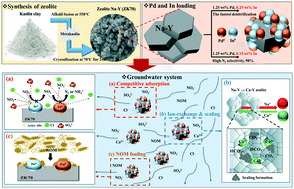Enhanced denitrification of contaminated groundwater by novel bimetallic catalysts supported on kaolin-derived zeolite: effects of natural dissolved inorganic and organic matter†
Abstract
Nitrate (NO3−) contamination has dramatically increased owing to extensive human activities, which may cause severe problems on human health and the environment. Recently, catalytic denitrification of NO3− to N2 has attracted much attention owing to its highly fast reaction with high N2 selectivity. However, only a few studies have investigated the effect of natural substances in real groundwater on catalytic denitrification, particularly the type of natural organic matter (NOM) and combined effect of NOM and ionic ions. Herein, we investigated the effects of natural dissolved inorganic and organic matter on catalytic denitrification of contaminated groundwater using a novel Pd–In bimetallic catalyst supported on kaolin-derived zeolite (ZK). Pd–In/ZK showed a highly enhanced performance for denitrification, resulting in a high turnover frequency (18.9 × 10−3 s−1) and N2 selectivity (98%). Various surface analyses confirmed that the rejuvenation of In by active H on Pd sites is the key factor that controls the enhanced NO3− reduction and high N2 selectivity. Applying the optimized Pd–In/ZK catalyst to NO3− contaminated groundwater revealed that its catalytic activity was significantly affected by various constituents in groundwater. Particularly, the results from fluorescence excitation emission matrix spectroscopy showed that humic-like and fulvic-like organic substances potentially inhibited the catalytic NO3− reduction owing to their adsorption onto the catalyst surface. Furthermore, some inorganic ions inhibited the catalytic NO3− reduction via different inhibitory mechanisms, i.e. the competitive adsorption of Cl− and SO42− with NO3− and catalyst fouling induced by formation of CaCO3(s). The novel findings from this study highlight the potential applicability of ZK as a value-adding support material for catalytic denitrification and emphasize the effect of dissolved organic and inorganic matters in groundwater on the catalytic activity of bimetallic catalysts.



 Please wait while we load your content...
Please wait while we load your content...